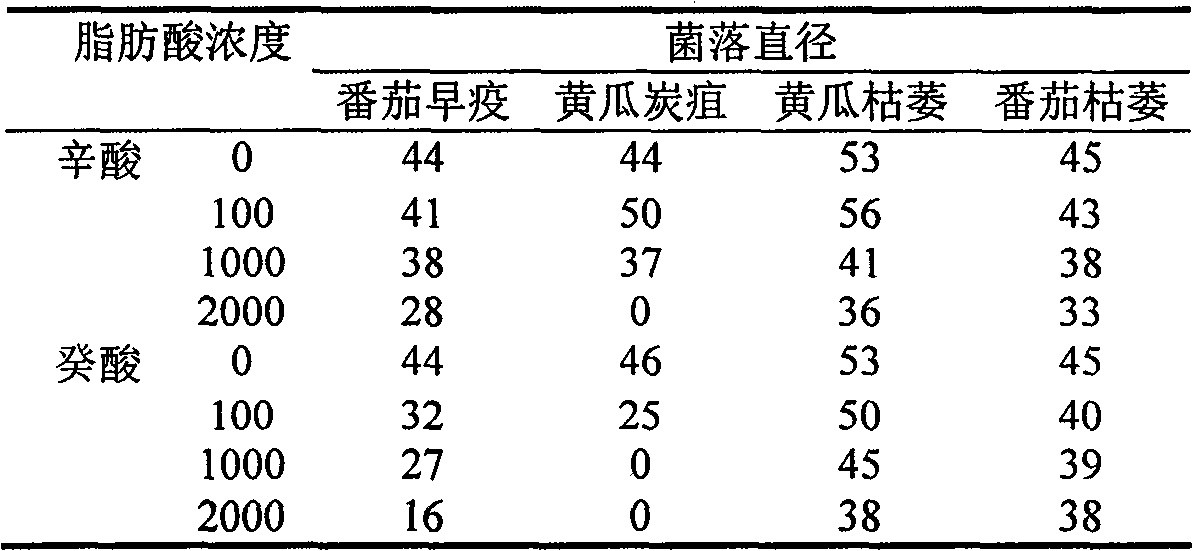Directional regulating agent of rhizosphere microorganism and nematode containing saturated fatty acid
A technology of microorganisms and fatty acids, applied in the directions of biocides, nematicides, plant growth regulators, etc., can solve problems such as the reduction of plant quality and yield, product quality and yield, and aggravation of diseases, so as to improve stress resistance, Low production cost and harm reduction effect
- Summary
- Abstract
- Description
- Claims
- Application Information
AI Technical Summary
Problems solved by technology
Method used
Image
Examples
Embodiment 1
[0018] Example 1. The improvement effect of mixed use of octanoic acid and capric acid on soil biological barriers. The mixing ratios of octanoic acid and capric acid were 0:100, 25:100, 50:50, 75:25, and 100:0, respectively. Preliminary seedbed test results indicated that a mixture of caprylic and capric acids was more effective than single caprylic or capric acids when applied on biotically dammed soils. Further trials are underway.
Embodiment 2
[0019] Example 2: Inhibitory effect of castor plant residues mixed with rapeseed cake on soil pathogenic nematodes. The mixing ratio of castor plant residue and rapeseed cake is 0:100, 25:75, 50:50, 75:25, 100:0. Pot experiments showed that two months after heat-treated soil was inoculated with root-knot nematodes, the reproduction coefficient of root-knot nematodes after planting castor was 0, while the reproduction coefficient of root-knot nematodes after planting peppers was 300. Knot nematode developmental potential. The preliminary seedbed test results showed that the control effect of castor plant residues and rapeseed cake mixture on pathogenic nematodes was better than that of castor plant residues or rapeseed cakes alone after nematode inoculation. Further trials are underway.
Embodiment 3
[0020] Example 3: The combined application of unsaturated fatty acids (caprylic acid and capric acid) and plant source materials (mixture of castor plant residues and rapeseed cake) on the soil with biological barriers. Select the soil where soil biological barriers occur, and heat treat in an oven for 8 hours at 65 degrees Celsius to kill nematodes. Put the treated soil into pots and mix them with "the rhizosphere microorganisms and nematodes directional regulator containing saturated fatty acids" and put them into pots, and sow and inoculate the pathogenic nematodes. Wherein the final content (mass percentage) of saturated fatty acid (caprylic acid and capric acid) in the soil substrate is 0.01%-10.0%, and the final content of plant source material (castor plant residue and rapeseed cake) in the cultivation substrate is 0.01% %-10.0% castor plant residues. Preliminary results showed that, compared with the control treatment without adding the "directed regulator of rhizosph...
PUM
 Login to View More
Login to View More Abstract
Description
Claims
Application Information
 Login to View More
Login to View More - R&D
- Intellectual Property
- Life Sciences
- Materials
- Tech Scout
- Unparalleled Data Quality
- Higher Quality Content
- 60% Fewer Hallucinations
Browse by: Latest US Patents, China's latest patents, Technical Efficacy Thesaurus, Application Domain, Technology Topic, Popular Technical Reports.
© 2025 PatSnap. All rights reserved.Legal|Privacy policy|Modern Slavery Act Transparency Statement|Sitemap|About US| Contact US: help@patsnap.com

